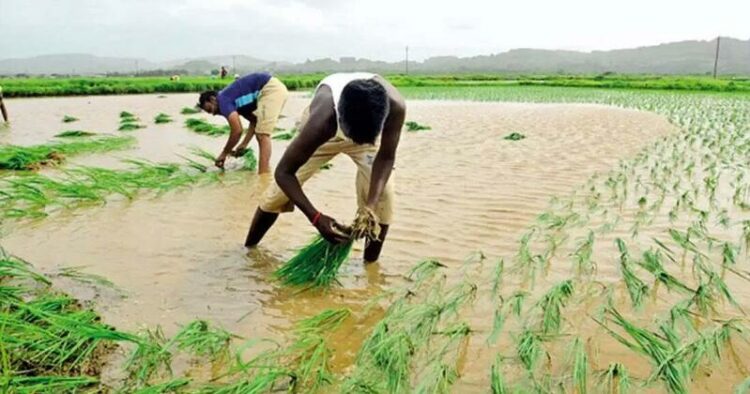Here is the ‘common man’ – CM – the Chief Minister of Gujarat — with his grand vision. Mentored by Prime Minister Narendra Modi during his initial days of political career, Mr Bhupendra Patel has developed a signature style of his own. He nurtures ambitious targets and unique dreams.
“PM Narendra Modiji has strategically combined the manpower in campaign to make Gujarat a water surplus state from a water deficit province,” he says.
A huge target. Nevertheless, there are plans and sincerity of purpose to achieve that.
The Gujarat planners know it pretty well that water is the centrepiece of development and hence ‘water management’ is a serious subject more so in a state which has the legacy of water deficiency.
According to officials, keeping in view the principle of ‘Per Drop More Crop’ the state government has kept a provision of Rs 5339 crore for the Water Resources Division in the Budget. Of course the state is committed to provide clean drinking water to all the villages under Nal Se Jal Yojana. Nearly 93 percent of the state is already connected by it.
In fact, Vadodara is now the sixth district in the state to get 100 percent Nal Se Jal after Botad, Anand, Gandhinagar, Mehsana and Porabdar districts.
The Sujalam Sufalam Jal Abhiyan is an immensely popular and successful initiative. This is water harvesting campaign and the first launched in 2018. This creates public awareness for the purpose of
collecting rainwater.
Well, there are results too and the experience is worth sharing as these are quite encouraging.
The ground water level in the state has risen due to initiatives for water storage, dimensions like check dams, Boribandh, Narmada Canal Network and Sauni Yojana besides the Sujalam Sufalam Jal Abhiya.
The Chief Minister Patel says, “Let us serve the nation by saving water and electricity. Through conscious use of water let us realise the dream of Atmanirbhar Gujarat and Atmanirbhar India. Let us make the earth prosperous by adopting Per Drop More Crop”.
A slew of measures and specially designed schemes have been taken up by the BJP government to improve water availability in the western state.
A provision of Rs 500 crore was done towards the works for laying long bulk pipeline from Bhavnagar, Gir-Somnath, Amreli, Botad, Junagadh, Rajkot and Porbandar to strengthen the drinking water facility in the Saurashtra region.
Gujarat has also made remarkable progress in the minco-irrigation initiative where 13 lakh farmers have
been benefited by putting in place micro irrigation in approximately 21 lakh hectre area.
In Budget 2022-23, the project that envisages lifting Narmada water from Tappar dam and pumping
it to around 100 reservoirs of Kutch region by digging seven link canals was provided with Rs 272 crore.
Nadi Utsav:
On the completion of 75 years of Independence as India celebrated Azadi Ka Amrut Mahotsav, Chief Minister Bhupendra Patel initiated the Nadi Utsav at Singanpore Cozway in Surat city. The Nadi Utsav is the collective effort of the Union Ministry of Jal Shakti, Ministry of Culture and Ministry of Tourism along with the state government. The festivals were organised along the banks of the river Narmada, Sabarmati and Tapti.
‘Acchey din for arid Saurashtra’ :
The much ambitious Saurashtra Narmada Avatarana Irrigation Yojana (SAUNI) project is set to supplement floor water to about 115 existing dams. As a result of this, arid Saurashtra in Gujarat will soon have ‘acchey din’. These dams have been selected based on the deficit storage study for last ten years.
The Phase I works started in April 2014 when Narendra Modi was still the chief minister of the western state and the project sought to strengthen irrigation facilities in 166,000 acre areas of 16 reservoirs. This phase of works is already commissioned at a total cost of Rs 6473 crore.
“With all the three phases done, the much talked about scarcity of water would be reduced in the Saurashtra region and in the ultimate it will strengthen existing facilities of irrigation for as much as 8,24,871 acre land,” says Rajkot Collector, Arun Mahesh Babu.
Saurashtra region is located in western part of Gujarat along the Arabian coast and covers 11 socially sensitive and politically crucial districts Rajkot, Jamnagar, Parbandar, Amreli, Junagadh, Bhavnagar, Surendranagar, Morbi, Devbhumi-Dwarka, Gir-Somnath and Botad.
Officials say the annual rainfall in Saurashtra region is 450-600 mm and is received on average within 20 45 days. Water scarcity is an issue though efforts were made to harness rainwater through 63,000 checkdams, 73,000 farm ponds etc. “Some larger intervention is required and hence the relevance of the SAUNI project,” says Collector Babu.
Local people especially in villages have their problems. The Bhader Dam, built for irrigation in 1994, in Gondal taluka is, for example, about 50 kilometre away from Moti Parabdi village.
Farmers complain of water shortage for their fields as tapped water is used during crises to meet the drinking water needs of Rajkot district. Villagers often have to resort to drilling exercise and in the process harm agi prospects of their land and also have to incur expenditures.
Now, officials say the SAUNI project will make a big difference in the entire region.
When all the three phases of works are complete, a total of 115 dams would be filled up. These include 24 in Rajkot, six in Morbi, one in Gir-Somnath, 3 in Botad, 24 in Jamnagar, 13 in Junagadh, 12 in Amreli and 11 in Bhavnagar and so on.


















Comments